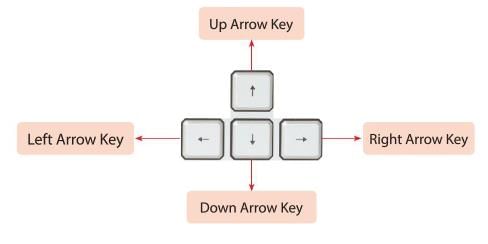Class 2 Exam > Class 2 Notes > Computer Studies Class 2 ICSE > Chapter Notes: Keyboard: Special Key
Keyboard: Special Key Chapter Notes | Computer Studies Class 2 ICSE PDF Download
Introduction
The keyboard is an essential input device used for typing letters, numbers, and other characters into a computer. This chapter introduces the different types of keys on a keyboard, focusing on special keys and their functions. Students will learn how to identify and use alphabet keys, number keys, punctuation keys, special keys, and combination keys to perform various tasks. Through practical activities, students will also understand how these keys help in typing and navigating on a computer.
Keyboard
- A keyboard is an input device used for typing.
- Pressing keys displays matching letters, numbers, or characters on the screen.
Alphabet (Letter Keys)
- These keys have letters from A to Z.
- Used for typing letters, words, and sentences.
- There are 26 alphabet keys arranged in three rows in a jumbled order.
Number Keys
- These keys have numbers from 0 to 9.
- Used for typing numbers.
- Found in two places: on top of the alphabet keys and on the numeric pad on the right side of the keyboard.
Special Keys
- Special keys perform specific tasks on a keyboard.
Caps Lock Key
- Used to type only capital letters.
- Press once to turn it ON for capital letters; press again to turn it OFF for small letters.
- A green light on the keyboard indicates if Caps Lock is ON or OFF.
Enter Key
- Moves the cursor to the start of the next line.
- Also called the Return key.
- A keyboard has two Enter keys.
Arrow Keys
- A keyboard has four arrow keys: Up, Down, Left, and Right.
- Up Arrow Key: Moves the cursor up.
- Down Arrow Key: Moves the cursor down.
- Left Arrow Key: Moves the cursor left.
- Right Arrow Key: Moves the cursor right.

Delete Key
- Deletes characters (letters, numbers, or symbols) to the right of the cursor.

Backspace Key
- Deletes characters to the left of the cursor.

Page Up/Page Down Keys
- Used to move a page up or down.

Function Keys
- A keyboard has 12 function keys (F1 to F12) for various tasks.
- Example: F2 key is used to rename a selected file or folder.

Punctuation Keys
- Used to type punctuation marks like full stop (.), question mark (?), comma (,), and exclamation mark (!).
- These symbols are called punctuation marks and are used in writing words, sentences, and paragraphs.

Combination Keys
- Used with other keys to perform specific tasks.
- Shift, Control (Ctrl), and Alt keys are combination keys.
Shift Key
- A keyboard has two Shift keys.
- Used with other keys for different tasks.
- Example: Press Shift with the number 2 key to type @.
- Can type capital letters when Caps Lock is OFF.

Control Key
- Represented as Ctrl on the keyboard.
- Used with other keys for specific tasks.
- Example: Ctrl + Home moves the cursor to the top of a document.
- Example: Ctrl + End moves the cursor to the bottom of a document.

Alt Key
- Performs specific tasks when used with other keys.
- Example: Alt + F4 closes a program.
- Example: Ctrl + Alt + Del shuts down a computer.

Tech Terms
- Cursor: A blinking vertical line on the screen.
Quick Recall
- A keyboard is an input device used for typing.
- Different keys have different functions.
- Types of keys include alphabet, number, special, punctuation, and combination keys.
- Special keys include Arrow, Delete, Backspace, Page Up/Down, and Function keys.
- Combination keys like Alt, Shift, and Control work with other keys for special tasks.
The document Keyboard: Special Key Chapter Notes | Computer Studies Class 2 ICSE is a part of the Class 2 Course Computer Studies Class 2 ICSE.
All you need of Class 2 at this link: Class 2
|
34 docs|7 tests
|
FAQs on Keyboard: Special Key Chapter Notes - Computer Studies Class 2 ICSE
| 1. What are the main functions of the special keys on a keyboard? |  |
Ans. The special keys on a keyboard include keys such as Caps Lock, Enter, Delete, Backspace, and Arrow keys. Each of these keys serves specific functions: Caps Lock allows users to type in uppercase without holding the Shift key, Enter is used to execute commands or create a new line, Delete removes characters to the right of the cursor, Backspace deletes characters to the left, and Arrow keys are used for navigation within text.
| 2. How does the Caps Lock key work? |  |
Ans. The Caps Lock key, when activated, changes the typing mode to uppercase letters for alphabetic keys without needing to hold down the Shift key. Pressing it again turns off this feature, returning the keyboard to its normal typing mode where letters are lowercase unless Shift is held.
| 3. What is the difference between the Delete key and the Backspace key? |  |
Ans. The Delete key removes characters to the right of the cursor, while the Backspace key deletes characters to the left. This distinction is important for editing text efficiently, allowing users to choose which direction to remove characters based on their needs.
| 4. How do the Arrow keys enhance navigation in text documents? |  |
Ans. Arrow keys allow users to navigate through text documents without using a mouse. The Up and Down arrow keys move the cursor vertically, while the Left and Right arrow keys move it horizontally. This makes it easier to edit or review text without changing hand positions away from the keyboard.
| 5. When should I use the Enter key while typing? |  |
Ans. The Enter key is primarily used to execute commands, create new paragraphs, or submit forms. In word processing, pressing Enter starts a new line, while in applications like spreadsheets, it can confirm data entry. Understanding when to use the Enter key is critical for effective typing and document formatting.
Related Searches





















